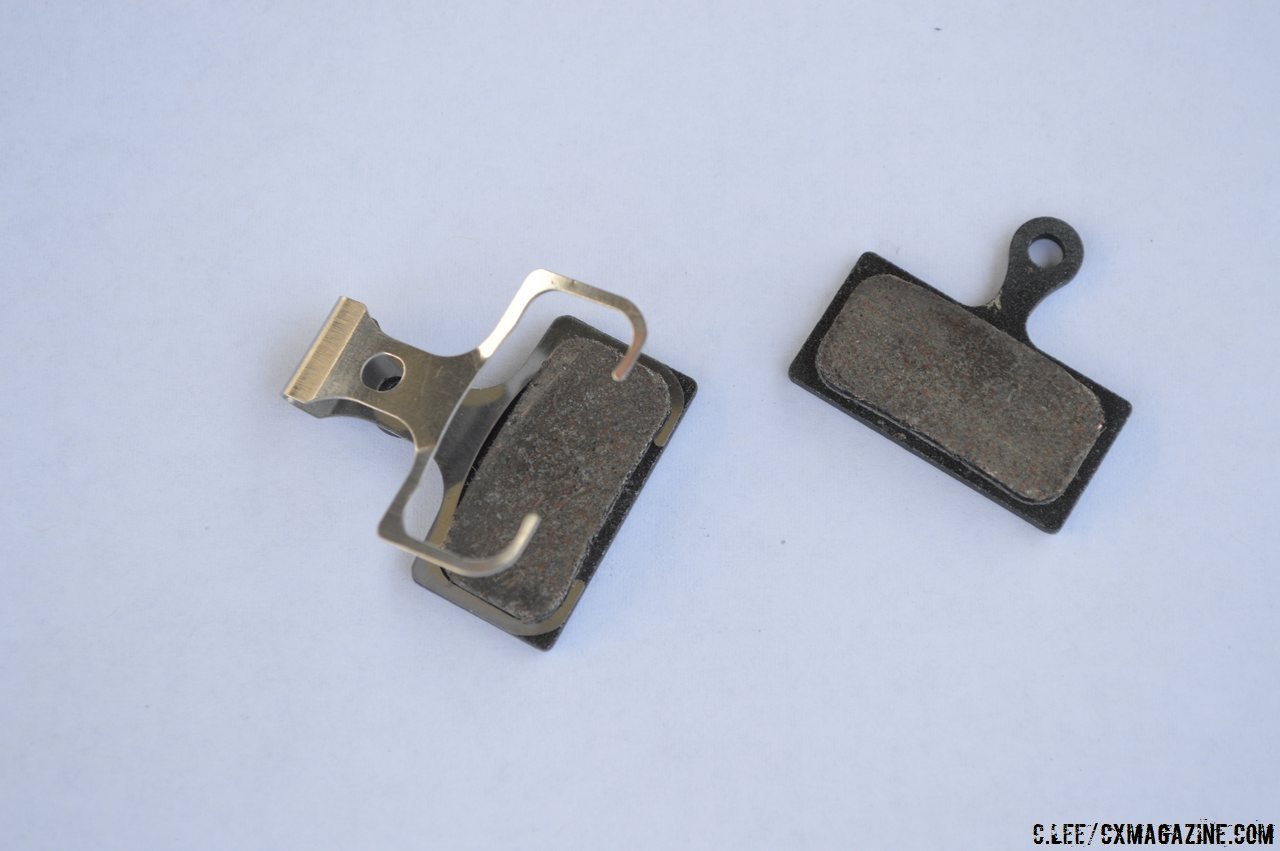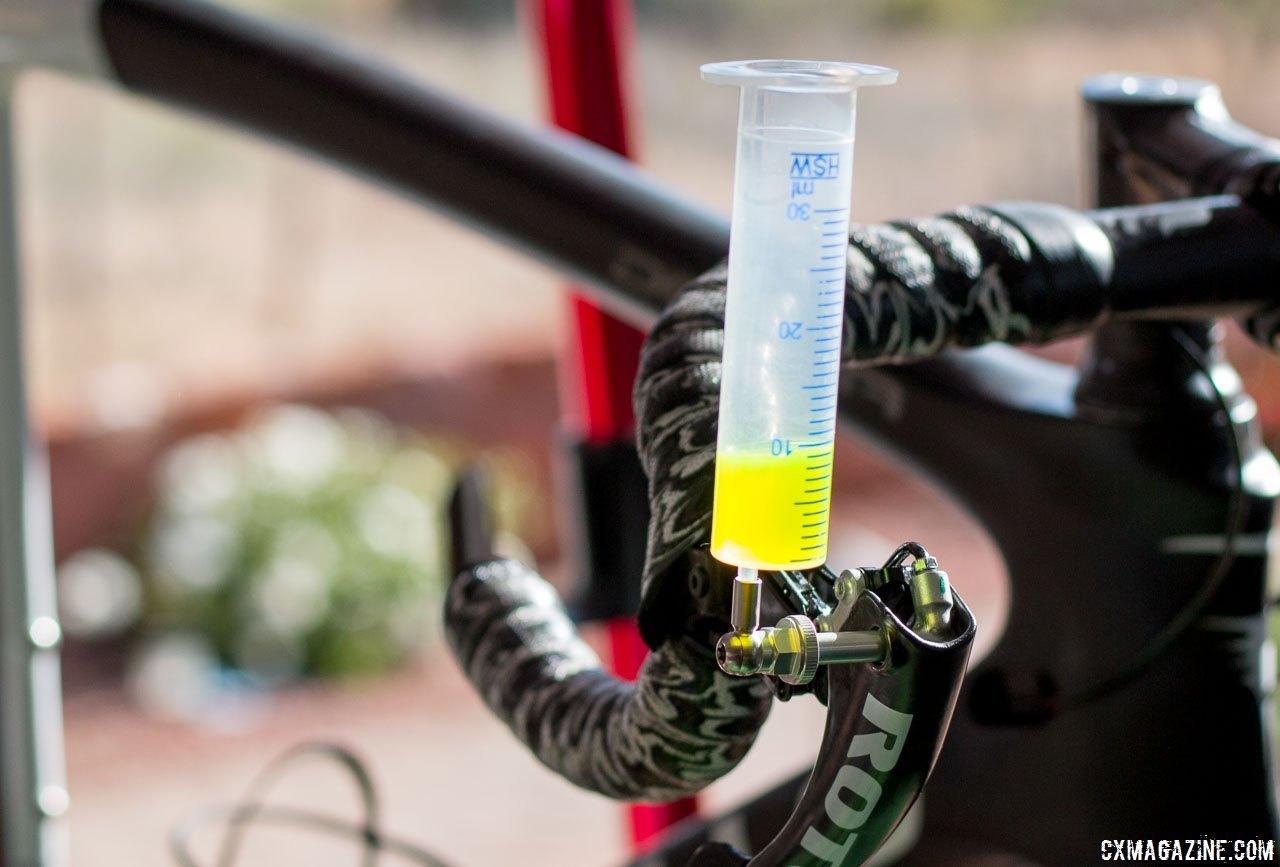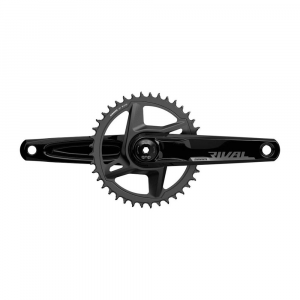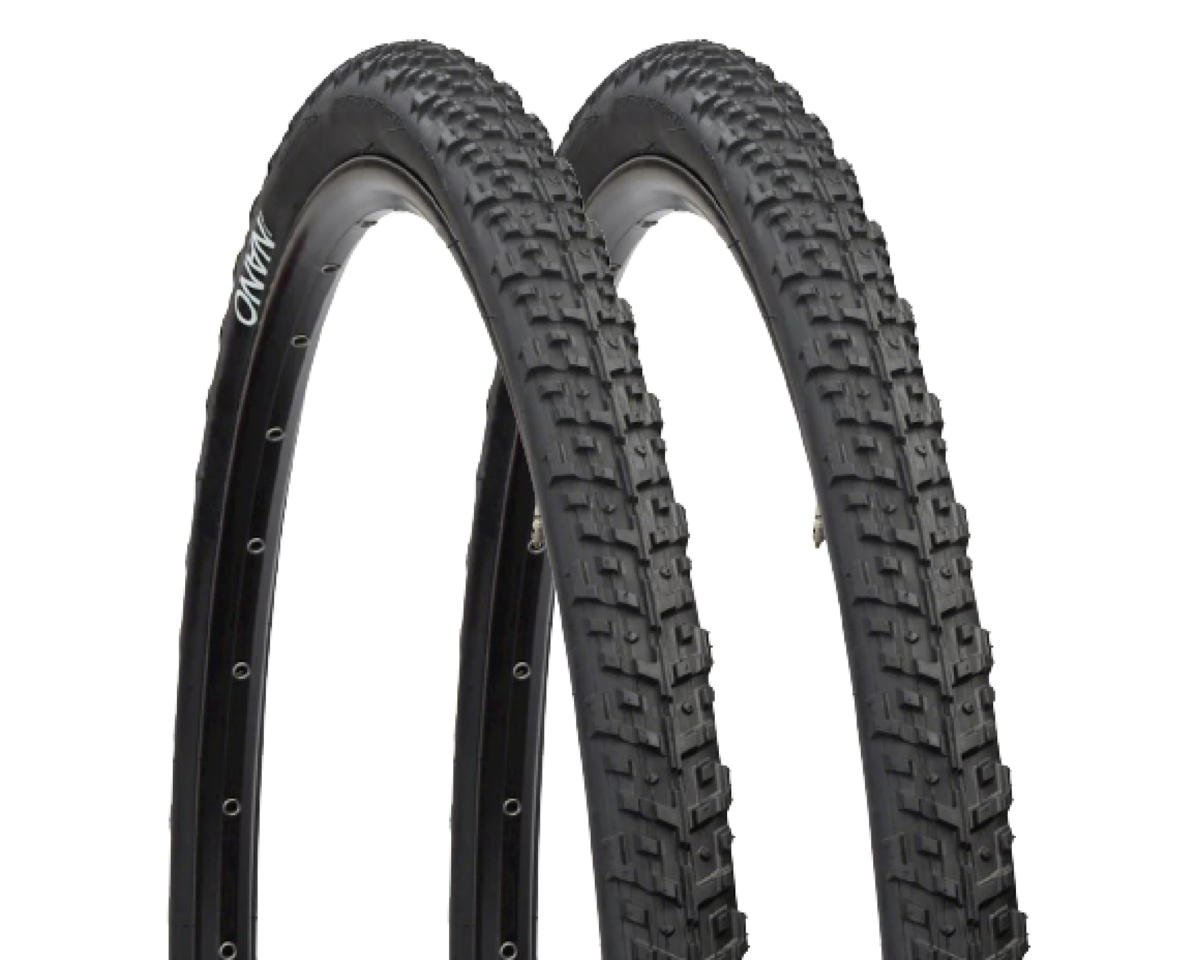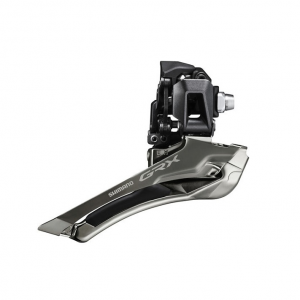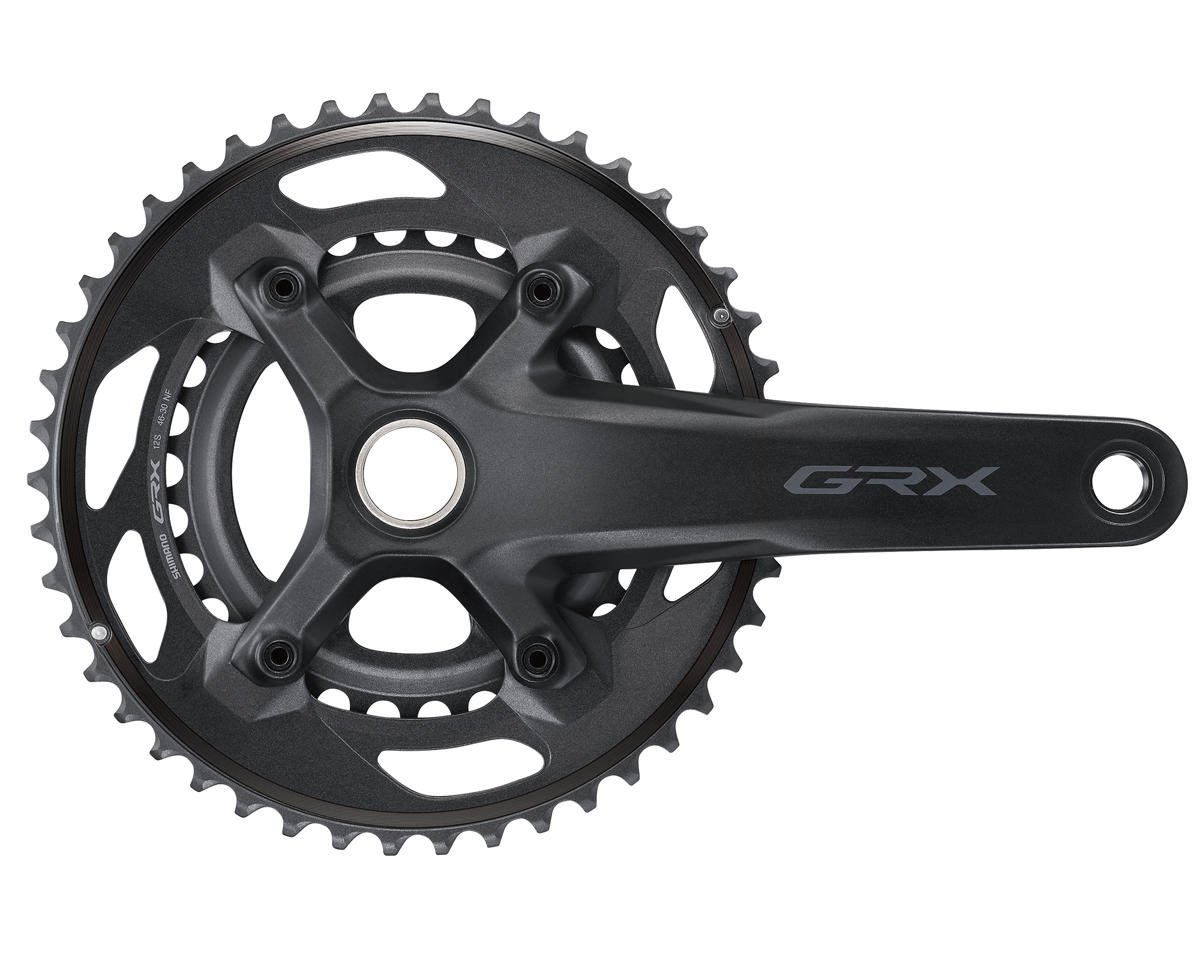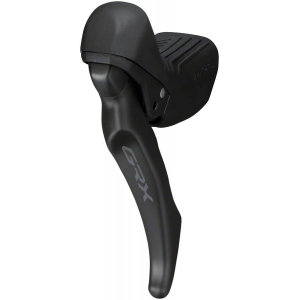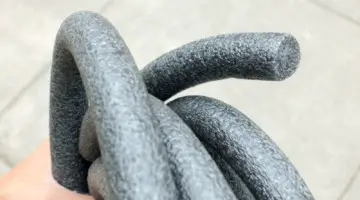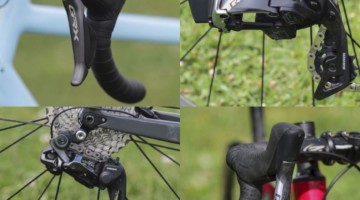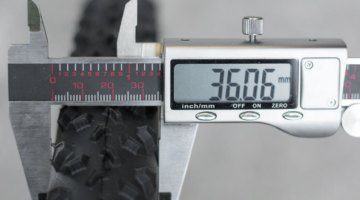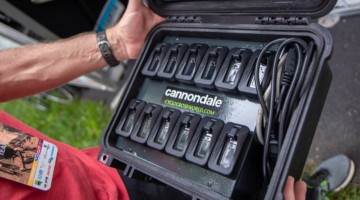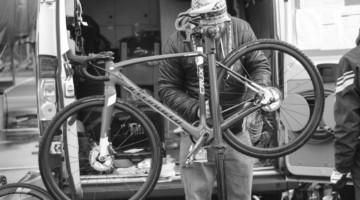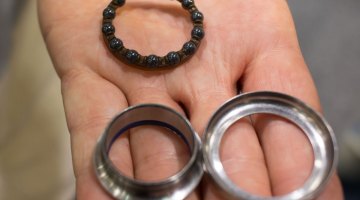It was only a few years ago that the first disc brake systems started to permeate the upper echelons of cyclocross. It didn’t take long for almost the entire professional field (with a few notable exceptions) to adopt discs completely.
Now in 2018, most bike manufacturers have been through at least one disc-only product cycle and a majority of amateurs are also riding disc brakes.
Despite the industry-wide switch, there is still a lot of mystery surrounding disc brakes for many of us. Confusion over axle standards, rotor sizes pad compounds and bleeding procedures are nothing new in the world of mountain bikes, but many cyclocross racers with a road background might find themselves playing catch up.
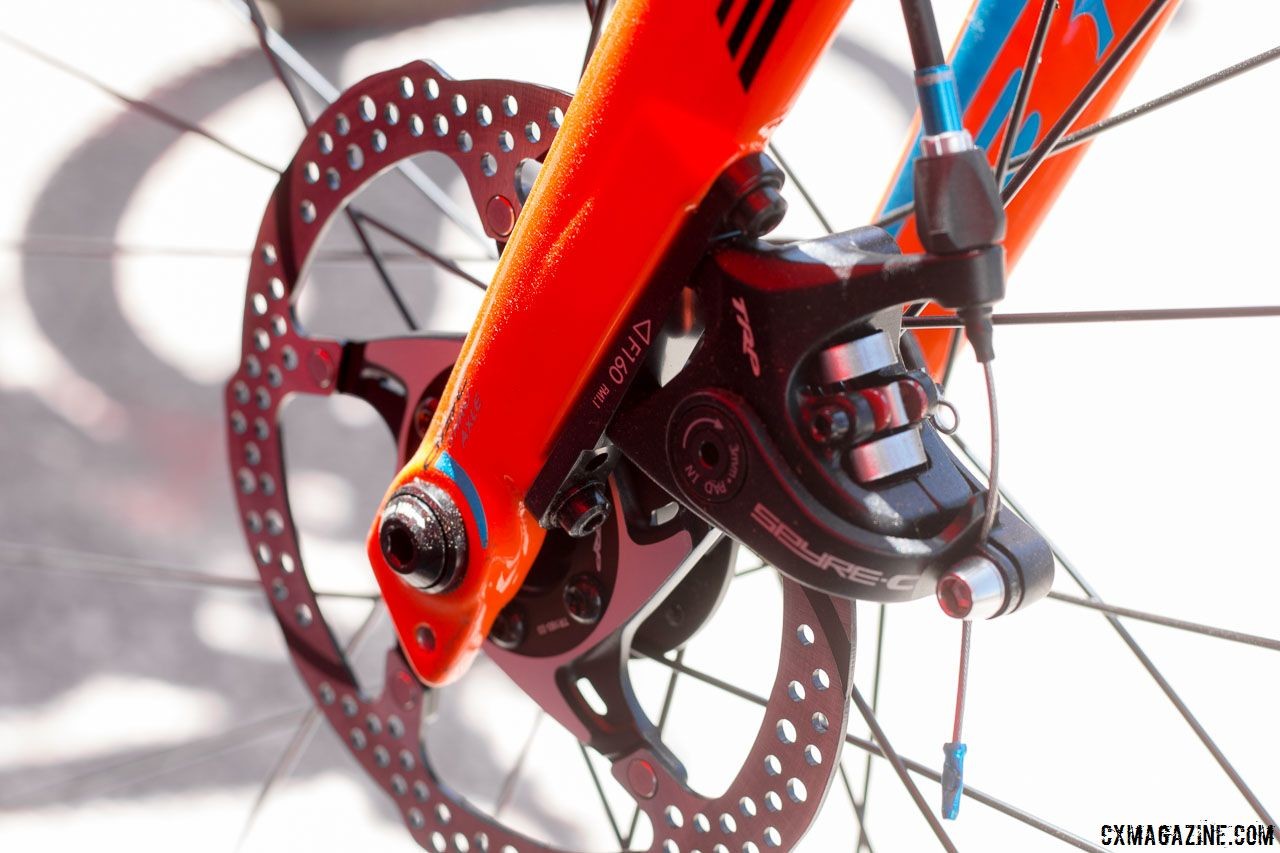
If you have questions about disc brakes, hopefully these mechanics have answers for you. BH Bikes Alloy Gravel X Bike. 2018 Sea Otter Classic. © Cyclocross Magazine
To help guide riders through the world of disc brakes, we asked some of the best in the business several questions about disc brakes in this installment of Ask the Mechanics.
Returning from previous editions on chains and cable systems are Mark Legg, aka Mr. Katie Compton, Mike Berry of Cannondale p/b CyclocrossWorld and Drew Esherick of Stan’s NoTubes.
For more from our expert mechanics, see our drivetrain and cable editions from last year.
Ask the Mechanics: Disc Brakes
Cyclocross Magazine: Do you recommend using different materials (organic, metallic, semi-metallic, etc.) for different conditions? If you use multiple types of pads, do you pair them to specific wheels or rotors?
Mark Legg: Yes, we run specific pads and rotors for specific course and conditions.
Mike Berry: Absolutely. Organic pads are great for dry, dusty conditions since they keep them quiet and wear is minimal. Metallic pads are best when it’s muddy; they are a bit noisier, but the wear is reduced. Typically those pads go with mud tire wheels.
Drew Esherick: I usually prefer the stock semi-metallic pads. It’s not uncommon to switch to full metallic for a really muddy day, otherwise you might end up out of brake pad in just a few laps.
CXM: What’s your bed-in procedure? When swapping rotors between different pads what bed-in is needed? Are there any incompatibilities between rotors and calipers?
MB: We use a lathe with a jig with a caliper and lever mounted to them. It allows us to spin up the rotor, bed them in with either organic or metallic pads and do it in large quantities one after another. You should always pair the caliper and rotor brands for best performance.
DE: After swapping the pads, I typically send the rider out for a spin around the parking lot or a slow lap on course. If they aren’t around, I’ll spin it around the parking lot, being sure to come to a long, controlled stop a few times.
ML: I bed in the rotors with specific pads here in Colorado Springs. I then label the rotors so I can swap them in when running specific pads.
CXM: How do you clean disc systems after a particularly muddy race? Is power washing bad for the system?
DE: I power wash them all the time. I haven’t seen any ill effects from it.
ML: Power washing doesn’t affect the brakes we use. The soap you use will affect the rotor and pad surface, which is one of the reasons we use Pedro’s 16X Green Fizz on the bikes. It doesn’t leave detergents that can affect the braking and traction on the bike. This was a major issue for us at Tabor World Championships which resulted in very slippery tires and very little braking traction. It was a lesson learned.
MB: Power washing is fine. Avoid using soaps and degreaser on the pads and rotors to avoid noise and contamination.
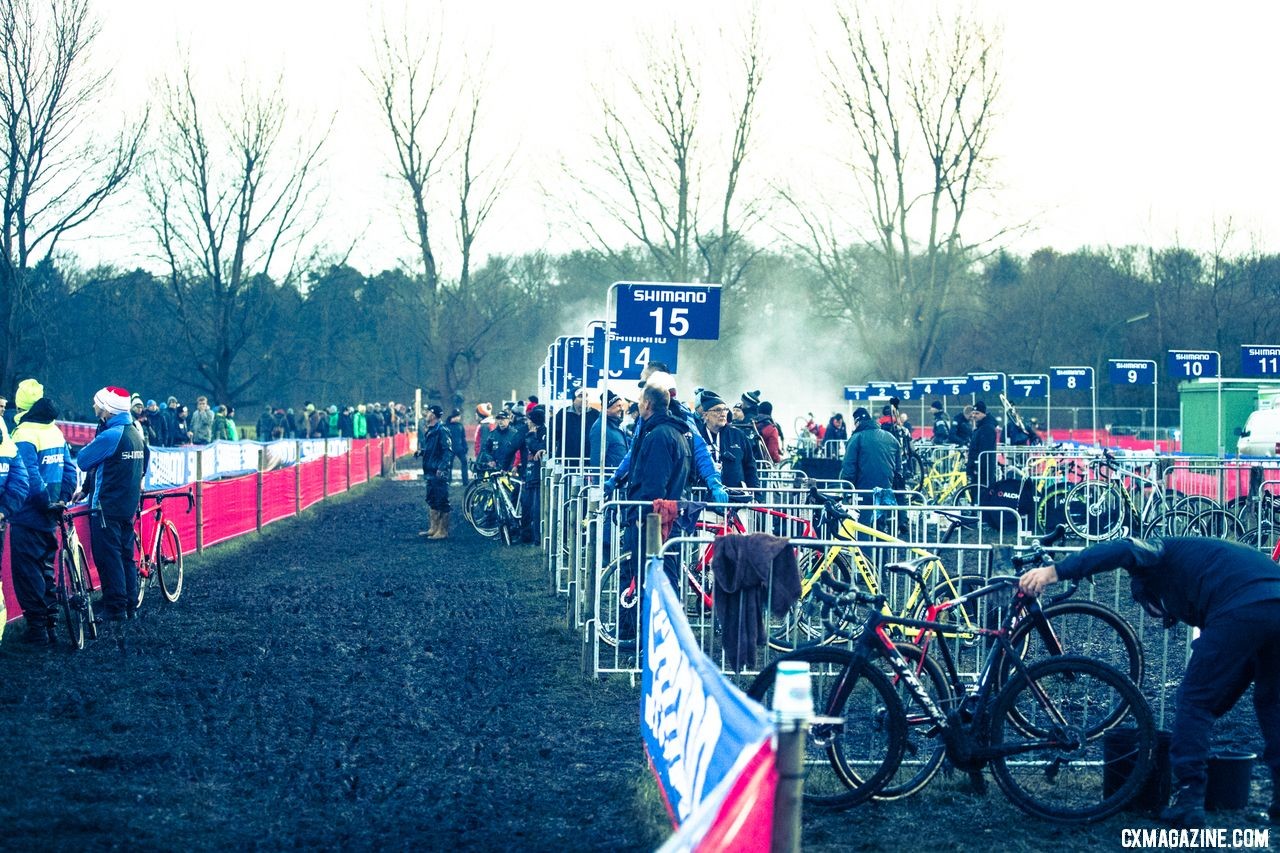
Power washing is okay, but be careful when using soaps and detergents near disc brakes. Elite Men, 2017 Zeven UCI Cyclocross World Cup. © J.Curtes / Cyclocross Magazine
CXM: Disc pads are known for their susceptibility to contamination. What do you do should pads contact lubricants or solvents?
ML: It’s best to wash the bikes without the brake pads and rotors on the bikes. I like to use isopropyl alcohol, but it is very hard to get in Belgium. In that case, I try to use a cleaner that does not leave any residue.
MB: Isopropyl alcohol on the rotor and a fine file on the pads. If that doesn’t resolve the issue, replace them.
DE: Unfortunately, if you contaminate the pads, it’s time for new ones. I always make sure to pull the pads if spraying chemicals near the calipers or bleeding the brakes.
CXM: What pad material do you think the average ’cross racer should use?
MB: Organic is great for everyone for most conditions. If you notice excessive wear, switch to a metallic pad but know you may wear rotors faster.
DE: The average ’cross racer will get really good performance out of the stock pads. They give a good combination of bite, longevity and low noise. Just make sure you check them regularly, especially after a muddy day.
ML: That really depends on the bike, the course and the riding style of the athlete. Some riders use their brakes to manipulate the bike around the course while others use the brakes to slow the bike and use their skills or power to set up the bike through corners.
This really asks the question that now we have braking systems we can use to manipulate the bike through corners, it depends on how much braking torque the rider is comfortable with. The more torque the more rotation you can induce with the bike. Some riders don’t use the brakes like this so they will need a brake setup with less torque and more modulation.
Then we need to take into consideration the course conditions. Dry slippery courses that often are in hot conditions require less torque and more modulation. Wet muddy races require more torque, which you can use to manipulate the bike to place the bike where you need it.
When in doubt go with more modulation over torque so you don’t overslow the bike into corners requiring more power to accelerate out of the corner.
CXM: How do you decide when pads need to be replaced?
DE: Visual inspection. Remove the pads, check how much material is worn and how far the pistons have extracted. It’s kind of a judgment call whether or not to go to new ones, depends on the weather, the course, etc.
ML: I replace the pads almost every race. Fresh pads mean less change in lever travel, so it’s more consistent for Katie. If you need to extend the life of your pads you can cut out some hard plastic and glue it onto the back of the pad to act as a spacer so it decreases brake lever travel.
MB: Visual inspection when washing can determine pad thickness and if the pad should be replaced.
CXM: What is your opinion on aftermarket versus OEM pads?
ML: I don’t have a lot of experience with aftermarket pads, but I am aware of some very good options out there. However, we run what we know; it saves having to relearn new pads in the wide variety of racing conditions we experience every season. If it works, don’t change it.
Once you change your braking setup you’re no longer operating on unconscious competence, you switch over to conscious incompetence or if you’re a highly skilled athlete you’ll switch to conscious competence. However, once you switch out of unconscious competence you will no longer be able to access your flow state.
Train your body with the brake pads you plan to race and learn what they will do in all conditions so you can better avoid having to focus on your braking. Once you stop thinking and start doing, you’ll be able to access your flow state more often. Once you have to think about your brakes you’ll never enter into a flow state.
MB: We tend to stick with OEM pads, but there are plenty of great aftermarket brands that’ll do the job.
DE: I always prefer the OE-spec pads. They are pretty much guaranteed to work best with whatever brake you have.
CXM: How often do you replace disc rotors during the season? Do you replace pads at the same time? Replace rotors when you change pads? Can you use a softer pad to prolong rotor life or are rotors a wear item?
MB: Rotors are a wear item, as are pads. We have so many wheels among so many riders, it would be difficult to keep track of all that. We replace rotors as they are needed. If you use a softer pad to save on rotors, you are reducing your braking performance to save rotor cost but replacing pads more often.
DE: I don’t typically replace the rotors very often. Maybe occasionally after a really muddy weekend, but unless the riders bend or dent a rotor, most of the wheels will have the same rotors all season.
ML: Shimano brake rotors don’t wear out for us; I have some rotors we’ll be racing this season that are three years old. They are durable and dependable. At the level Katie is racing, durability affects our investment in our equipment. It’s our money we spend on equipment, so we need it to be dependable and durable.
The easiest way to save your equipment is to wash your bikes and maintain a clean drivetrain and braking system. Dirty equipment simply wears out faster. Bike washing is an investment in your equipment and your racing, which is why I call myself a professional bike washer.
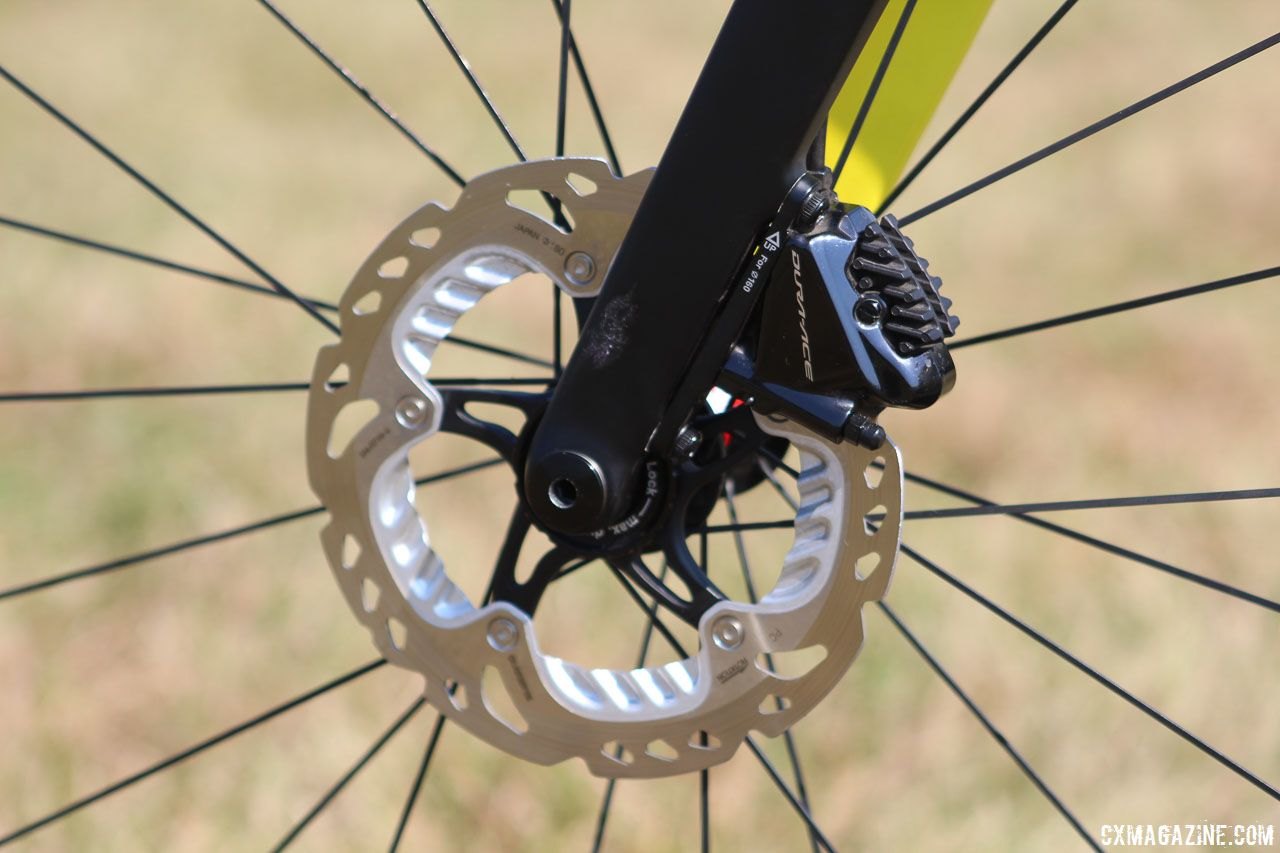
The mechanics often use visual inspection to check rotor wear. Lucie Chainel’s Canyon Inflite, 2017 World Cup Waterloo. © Z. Schuster / Cyclocross Magazine
CXM: Disc rotors often do not line up perfectly from wheel to wheel, especially across multiple hub brands. How do you deal with tolerance differences to prevent brake rub?
DE: The best way is to have all the same wheels, of course. But if that isn’t an option, you’ve got to re-center the caliper every time you swap a wheel. It’s usually pretty quick to do, so it’s not too much of a worry, even in the pit.
ML: With the wheels we run, brake rotor and cassette tolerance issues are not a factor for us. We’re fortunate to race on the wheels we want to race on.
MB: There are several shims of different thickness available for 6-bolt and CenterLock that can solve that. Or stick with the same hub manufacturer across all wheels.
CXM: Any tips for quick wheel changes?
ML: Slow down to go faster.
MB: Practice, practice, practice.
DE: Smooth is fast. Just don’t panic. Typically it’s not a problem in the pro races, as mechanics have at least half a lap after the bike swap.
CXM: How do you transport wheels to prevent rotor bending?
MB: Very carefully. We transport them in the trailer with special adapters we created on our Thule wheel holders mounted on the wall.
DE: If flying with or shipping a bike, always remove the rotors from the wheels (CenterLock makes this really easy). Otherwise, I keep all the wheels in wheel bags to prevents them from banging off anything in the van.
ML: We fly and drive our wheels around the U.S.and Europe, and it’s made a lot easier with CenterLock rotors since they are super-easy to remove. I store the rotors in a plastic case when we’re flying or driving.
CXM: Do you replace brake lines due to damage with any greater frequency than housing on cable brake systems?
DE: You don’t see a lot of brake line damage typically. Housing and cables get replaced way more often. Some of the changeable internal routing plates can rub or cut the brake line. I’ve probably only had to replace a handful of brake lines over the last few years.
ML: No.
MB: Hydraulic lines are inspected daily and replaced if they show any signs of wear or cracking. I would say as long as the line has an appropriate length and doesn’t rub the frame or bars, it should last the same if not longer than cable housing.
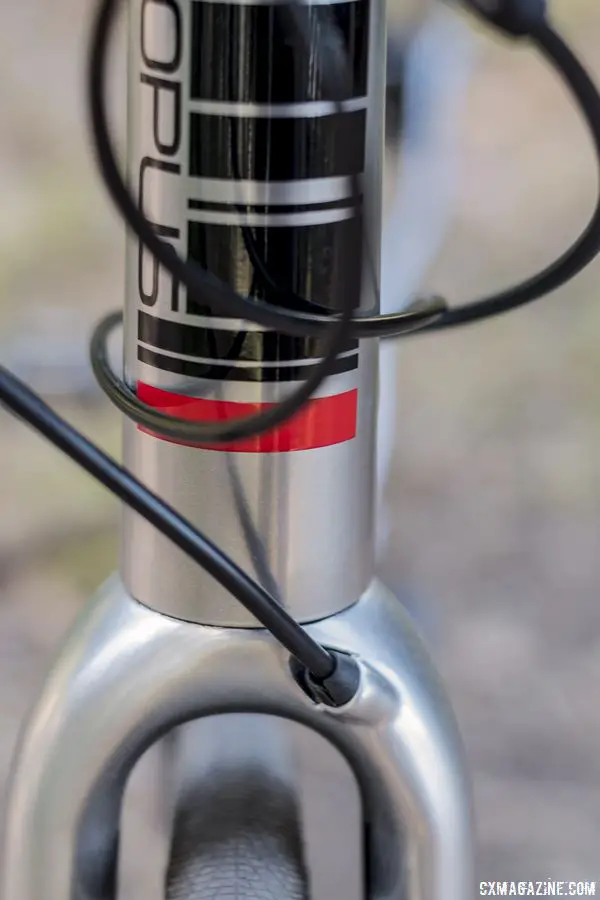
The mechanics are not forced to replace brake lines very often. Opus Spark 1 gravel bike. © C. Lee / Cyclocross Magazine
CXM: How often do you bleed brake lines?
ML: Only once when I build the bikes. My bleed kits don’t get used during the season.
MB: As needed, any sign of poor lever feel and we bleed them.
DE: Whenever a rider mentions that the brake is feeling a bit soft. Thankfully the hydraulic systems are really great and get more and more refinement every year. Once or twice per season is fairly average.
CXM: Do you use OEM or an aftermarket brake fluid (either DOT 5.1 for SRAM or mineral oil for Shimano)?
MB: OEM only.
DE: Same answer as the brake pad question here. I always stick with the OE oil/fluid. They are specifically formulated and tested with their brakes in mind.
ML: Shimano mineral oil always for Shimano brakes. It’s not toxic like the DOT fluid, which is safer for me and I don’t have to worry about dumping excess mineral oil in the mint garden next to the garage.
CXM: What are some common mistakes you see amateur ’cross racers make with their disc brake setups?
DE: The most common thing would probably be trying to save contaminated pads. Once you’ve gotten oil on them, its time for new pads. There really isn’t any saving them.
ML: I don’t really have experience with other racers these days since I only work on Katie’s bikes, which keeps me plenty busy because I’m a little fanatical with her bike setup. Probably the most common one is not cleaning your equipment and not bringing extra brake pads to the races.
MB: If the money is available, use a hydraulic system over cables. A hydraulic piston both moves and re-adjusts based on pad wear, giving more consistent braking over the life of the pad.
CXM: With a few seasons of experience with discs, are there any sticking points of disc design that you wish manufacturers would address or features you wish could be added?
ML: Lighter weight rotors is always on the “want list” since rotational weight is a performance killer. I’m curious to see if we’re going to follow motor racing and go with carbon rotors. I would be nice to have a couple more brake pad options like motor-sports with varying degrees of initial torque and durability. Overall everything comes down to wanting lower weight and increased durability, which is challenging with small components when trying to hit an affordable price point for consumers with low production numbers
MB: Going back to the need for adjustment based on hub/rotor location. A standard needs to be made so that they are all the same. An inexpensive stamped steel 6-bolt rotor and an expensive alloy carrier CenterLock rotor should all have the same distance between the center of the rotor and the face of the hub mounting surface.
DE: I think they’re doing a great job, I really can’t think of something to change or add. I think disc brakes are definitely the way to go. I know there are still some people out there who swear by the cantilevers, but disc brakes give you more control, more power and more margin for error out on the course.
CXM: Thanks for your time. Looking forward to seeing you in action at races this fall.













